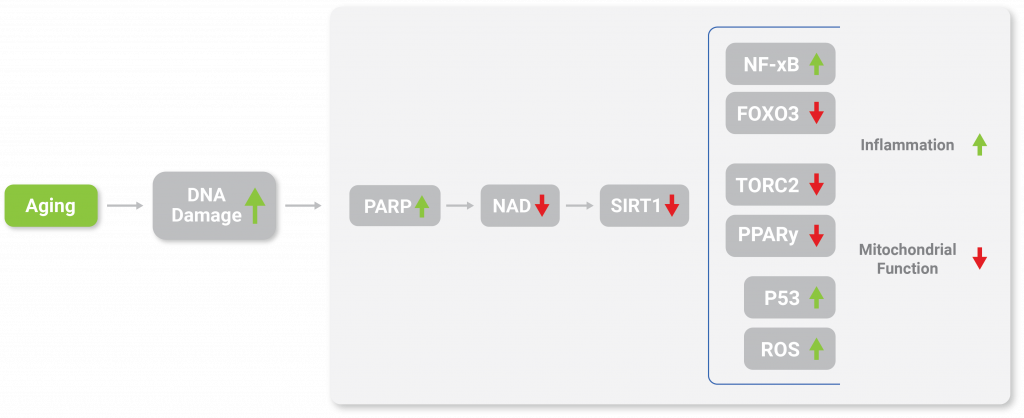Nicotinamide adenine dinucleotide (NAD+) is a critical player in an array of processes from creating energy for and maintaining the health of cells as well as controlling cell behaviors, such as immune responses to viral infections. In both animals and people, levels of NAD+ diminish with age. This reduction comes as a cost to our health. Of note, it can negatively impact the immune response to infection, including our response to COVID-19. Data shows that the death rates from COVID-19 increase with age and, for those older than 80 years, it passes 14%, suggesting age-related immune system dysfunction. This begs the question: what’s the link between NAD+ levels, COVID-19, age, and mortality.
(Omran & Almaliki, 2020 | Journal of Infection and Public Health)
Scientists from Bahrain published a proposal in the Journal of Infection and Public Health on how COVID-19 infection itself depletes NAD+ levels to affect our immune response. This paper suggests that perhaps restoring NAD+ concentrations could diminish the severity of the body’s immune reaction to the infection to improve the condition of COVID-19 patients. They believe that reaching a better understanding of the immune response to COVID-19 will make the development of therapeutic options possible.
NAD+ Keeps Our Immune System in Tip-Top Shape
Aging affects how well our immune systems can respond. This is in part thought to be related to telomeres — protective caps located at chromosomes ends that play an essential role in preserving chromosome stability. Telomere length is very important to the immune system because of the high sensitivity of the immune cells to the shortening of telomeres. Telomeres shortening adversely affect the immune cells’ function and developments. These adverse changes increased the susceptibility for severe infection, risk of hospitalization, and even death.
To maintain telomere length, enzymes that are dependent on NAD+ called sirtuins activate protective gene programs. But NAD+ levels decrease with aging, which adversely affects sirtuin activity. This is thought to be a key reason why with age cells see reductions in telomere length, which ultimately can induce cell death and tissue deterioration.
NAD+ Consumption Is Key to Viral Responses
NAD+ plays a key role in the body’s antiviral response. At the heart of this mechanism is a protein called poly-ADP ribose polymerase-1 (PARP-1), which stimulates the breakdown of NAD+ to execute antiviral functions. PARP-1 works by tagging the viral genome with a molecular component that results from the breakdown of NAD+ called ADP-ribose, which inhibits the activation of viral gene programs.
But the viral family that SARS-CoV-2 comes from, Coronaviridae, has a way to remove the ADP-ribose molecular tag, which inhibits the protective effect of PARP-1. As a result, more and more PARP-1 gets activated, leading to an excessive inflammatory response that can be harmful.
With the elevated PARP-1 activity and resulting inflammation from SARS-CoV2, there is an increase in NAD+ consumption and reductions in NAD+ levels. Since NAD+ is needed for all sorts of essential cellular processes like energy production, our cells become depleted of energy and subsequently die. What’s more, this all leads to reduced activity of an enzyme linked to longevity called sirtuin 1 (SIRT1) that maintains the integrity of our DNA and the health of our cells.
(Omran & Almaliki, 2020 | Journal of Infection and Public Health) DNA damage from aging leads to PARP-1 activation, decreasing NAD+ levels. This scenario results in a decline in SIRT1 activity which then facilitates increased inflammation and reduced mitochondrial function.
Can NAD+ Supplementation Modulate Immune Responses?
In their proposal, Omran and Almaliki said, “This process of PARP-1 overactivation can be reversed by exogenous NAD+ administration.” They propose that this inhibition of PARP-1 also prevents the activation of a protein complex called NF-KB that has an essential role in the inflammatory response to SARS-CoV-2 infection.
“We suggested the use of NAD+ as an immunomodulator for COVID-19 in older patients. Restoring normal NAD+ levels could decrease the severity of immune reaction in those patients and improve their clinical condition,” stated the team in their publication. They conclude that a better understanding of the immune response against SARS-CoV-2 may contribute to developing preventative therapeutic strategies to fight the virus.

